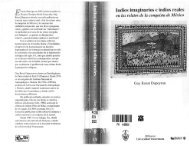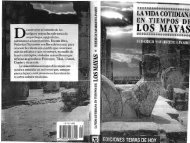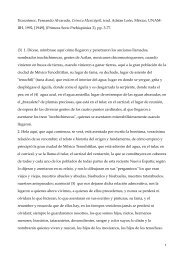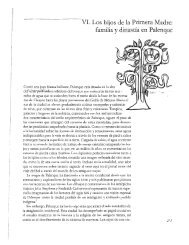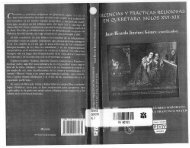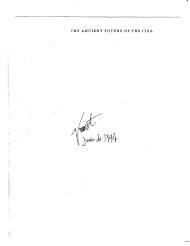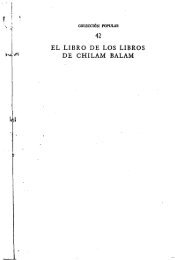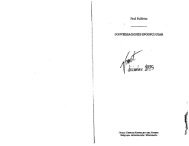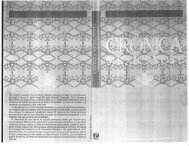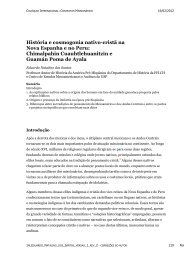HEAVEN BORN MERIDA AND ITS DESTINY - Histomesoamericana
HEAVEN BORN MERIDA AND ITS DESTINY - Histomesoamericana
HEAVEN BORN MERIDA AND ITS DESTINY - Histomesoamericana
Create successful ePaper yourself
Turn your PDF publications into a flip-book with our unique Google optimized e-Paper software.
28 INTRODUCTION<br />
Act 9. Seating of the Katun. It appears that seven lords may have been<br />
seated: Mutecpul (as Jaguar), Can Ul, Uayom Ch'ich', Nunil, Chable, Hoi<br />
Tun Balam, and Yaxum. (At least three of these are characters in "The Fall<br />
of Mayapan": Can Ul, Uayom Ch'ich', and Chable.)<br />
Act 10. Seating the Yearbearers. Five lords are named: Hoi Tun Ake,<br />
Zabac Na, Hoi Tun Balam, Pochek Ix Tz'oy (a Xiu from Copo, presumably<br />
the Spokesman), and Chac Te. If Pochek Ix Tz'oy was the Spokesman, the<br />
other four were presumably the Ba Cabs.<br />
Act 11. Pacing. The 7 Pacers appear and survey and seat the lands.<br />
Act 12. Dawn. The text doesn't say so, but presumably the mats (lordships)<br />
were counted; then tribute was collected.<br />
Act 13. Sacrifice. This is acted out as a scene from "The Fall of Mayapan,"<br />
the victim being cast as Mex Cue, who was thrown into the cenote<br />
of Chichen Itza by Hunac Ceel in 8 Ahau (1451). Cau Ich apparently replaced<br />
Mex Cue as governor of Mayapan at that time.<br />
Act 14. Examination. No feast is mentioned but presumably there was<br />
one. The examination is rather obliquely referred to, and there is reference<br />
to another scene from "The Fall of Mayapan," apparently relating to the<br />
birth of Mex Cue.<br />
Act 15. The Word. The word of the katun is announced by the impersonator<br />
of Mex Cue, presumably as a Jaguar of 8 Ahau.<br />
Act 16. Penance. There is only a fleeting allusion to suffering, but it<br />
comes at the right point and presumably represents the penance of the<br />
yearbearers, here played as Mex Cue, Cau Ich, Hunac Ceel, and the sun<br />
priest of Coba, all of them real people of 8 Ahau.<br />
Act 17. Commemoration. What are commemorated are not only the fall<br />
of Mayapan but also the beginning of the calendar round in 1529 (which<br />
would have been the time for the induction of the Jaguar designate for the<br />
1539 ceremonial being described here) and an eclipse.<br />
Act 18. Counting. The text alludes briefly to the writing of the katun<br />
history for 13 Ahau, now ended.<br />
Act 19. Farce. In this case the farce is called "Centipedes and Gnats,"<br />
presumably a burlesque of the pesky military orders.<br />
Act 20. Sermon. The text peters out in the midst of dire predictions of<br />
war and bloodshed.<br />
The ceremonial of the may in chapter 12 is that for 11 Ahau in 1539.<br />
Another version is given in more fragmentary form in chapter 46 for the<br />
11 Ahau of 1824. Five of the thirteen acts are-omitted. The circuit (act 8)<br />
is probably taken for granted. The seating of the yearbearers (act 10) may<br />
be omitted in honor of the impending calendar round celebration, which<br />
fell in 1841, later in the same katun. (This is referred to in line 6284.) The<br />
pacing (act 11) may have been deferred because land titles were still under<br />
negotiation (line 6462). The counting (act 18), like the circuit, is often<br />
taken for granted. It is possible that the farce (act 19) is referred to, but<br />
out of order (line 6287). The remaining eight acts are alluded to in order<br />
as indicated in the translation. The commemoration (act 17) enacts the<br />
story of Antonio Martinez, a latter-day prophet who identifies himself



